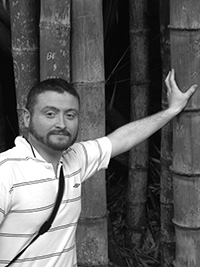Luca Rossato

XXIX Cycle - (A.A. 2013-2014)
IDAUP
Home Institution: University of Ferrara
Scholarship
Curriculum: Architecture (ICAR17)
Research Topic: Digital preservation of modern heritage
Tutor DA-UNIFE: Marcello Balzani
Tutor Polis University: Artan Fuga
Nationality: Italian
Email: luca.rossato@unife.it
Profile
Biography
PhD in “Architecture & Urban Planning”, Department of Architecture, University of Ferrara, Italy. Second Level Master in “Urban and Regional Planning in Developing Countries” IUAV University of Venice. M.Sc in Architecture at University of Ferrara. Contract professor at the Department of Architecture, University of Ferrara (from 2013 to 2016 SSD ICAR/17), he has been visiting professor at Pontificia Universidade Catolica do Paranà (Curitiba, Brazil), CEPT University (Ahmedabad, India), Mackenzie University (São Paulo, Brazil) and Burgundy School of Business (Dijon, France).
He’s deeply involved in publication fields and he’s been member of editorial staff for “Paesaggio Urbano”, “Architetti.com progetto e immagine digitale”, and “Architetti idee cultura e progetto”, editor of the Australian magazine “Journal of Architectural Research and Development” and author and co-author of more than 100 publications such as conference papers, magazine articles and book chapters.
Research skills
digital technology | modern architecture | vernacular architecture | urban survey | architectural survey
Scientific activities
ORCID ID:
0000-0002-3504-8384
IRIS UNIFE ID:
rp08943
Doctoral research
The sustainability of preservation. Integration of survey and documentation processes
with technologies for the conservation of 20th century architectures in Brazil and India
The research explores the current state of art of 20th century buildings both in Brazil and India and possible future challenges related to the preservation of design process and buildings by the use of contemporary methodologies and technologies. Thanks to an international cooperation net it has been possible to take advantage of the technological innovation in the field of cultural heritage preservation: technology is currently an important tool to support the commitments of conservators ad researchers. This technologies need to by hybridized with the knowledge of architects and conservators and only a gentle process of adapting methods and experimental protocols may allow, in fact, the use innovative techniques in this field. Sometimes these technologies are economically uncompetitive if transposed to cultural heritage preservation processes without the right methodology and proper use; thus the research proposes and integrated methodology able to adapt itself to local context being, at the same time, flexible and inexpensive. The integration of survey and representation techniques applied on the modernist architecture has been very effective and improved the knowledge towards peculiar aspect of the architectural object. The interaction of different technologies allowed also to exploit the advantages of each, and even diminish the effect of the specific weaknesses. The research path was then split in two: on one hand the evaluation of available tools, protocols and procedures, which make possible the use of equipment for modern heritage preservation and, on the other hand, the identification of more than 250 buildings both Brazilians and Indians of the modernist period, on the which to applied three different filters of selection. Within this framework the research has identified 80 buildings for application of data sheet and representation techniques, 25 buildings for application of BIM approach and 3 for 3D laser scanner survey application.
Keywords
brazil | india | integrated survey | digital memory | XX century

